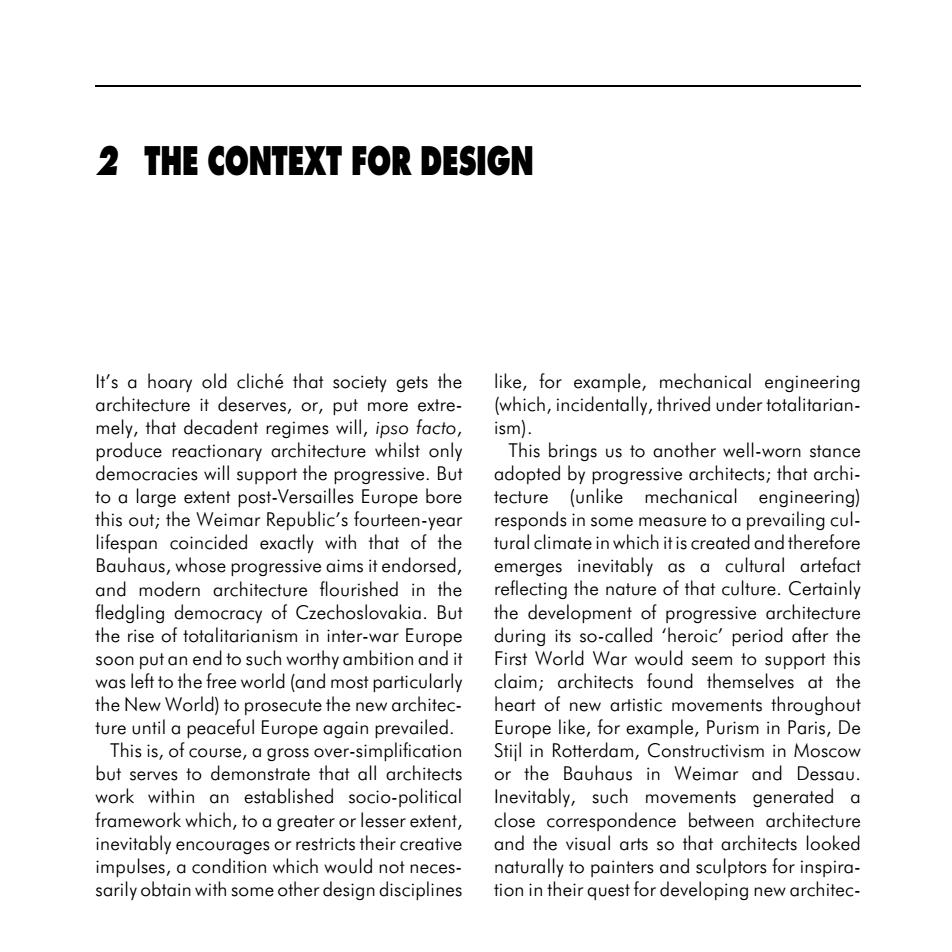正在加载图片...

2 THE CONTEXT FOR DESIGN It's a hoary old cliche that society gets the like,for example,mechanical engineering architecture it deserves,or,put more extre- (which,incidentally,thrived under totalitarian- mely,that decadent regimes will,ipso facto, ism). produce reactionary architecture whilst only This brings us to another well-worn stance democracies will support the progressive.But adopted by progressive architects;that archi- to a large extent post-Versailles Europe bore tecture (unlike mechanical engineering) this out;the Weimar Republic's fourteen-year responds in some measure to a prevailing cul- lifespan coincided exactly with that of the tural climate in which it is created and therefore Bauhaus,whose progressive aims it endorsed, emerges inevitably as a cultural artefact and modern architecture flourished in the reflecting the nature of that culture.Certainly fledgling democracy of Czechoslovakia.But the development of progressive architecture the rise of totalitarianism in inter-war Europe during its so-called heroic'period after the soon put an end to such worthy ambition and it First World War would seem to support this was left to the free world (and most particularly claim;architects found themselves at the the New World)to prosecute the new architec- heart of new artistic movements throughout ture until a peaceful Europe again prevailed. Europe like,for example,Purism in Paris,De This is,of course,a gross over-simplification Stijl in Rotterdam,Constructivism in Moscow but serves to demonstrate that all architects or the Bauhaus in Weimar and Dessau. work within an established socio-political Inevitably,such movements generated a framework which,to a greater or lesser extent, close correspondence between architecture inevitably encourages or restricts their creative and the visual arts so that architects looked impulses,a condition which would not neces- naturally to painters and sculptors for inspira- sarily obtain with some other design disciplines tion in their quest for developing new architec-2 THE CONTEXT FOR DESIGN It’s a hoary old cliche´ that society gets the architecture it deserves, or, put more extremely, that decadent regimes will, ipso facto, produce reactionary architecture whilst only democracies will support the progressive. But to a large extent post-Versailles Europe bore this out; the Weimar Republic’s fourteen-year lifespan coincided exactly with that of the Bauhaus, whose progressive aims it endorsed, and modern architecture flourished in the fledgling democracy of Czechoslovakia. But the rise of totalitarianism in inter-war Europe soon put an end to such worthy ambition and it was left to the free world (and most particularly the New World) to prosecute the new architecture until a peaceful Europe again prevailed. This is, of course, a gross over-simplification but serves to demonstrate that all architects work within an established socio-political framework which, to a greater or lesser extent, inevitably encourages or restricts their creative impulses, a condition which would not necessarily obtain with some other design disciplines like, for example, mechanical engineering (which, incidentally, thrived under totalitarianism). This brings us to another well-worn stance adopted by progressive architects; that architecture (unlike mechanical engineering) responds in some measure to a prevailing cultural climate in which it is created and therefore emerges inevitably as a cultural artefact reflecting the nature of that culture. Certainly the development of progressive architecture during its so-called ‘heroic’ period after the First World War would seem to support this claim; architects found themselves at the heart of new artistic movements throughout Europe like, for example, Purism in Paris, De Stijl in Rotterdam, Constructivism in Moscow or the Bauhaus in Weimar and Dessau. Inevitably, such movements generated a close correspondence between architecture and the visual arts so that architects looked naturally to painters and sculptors for inspiration in their quest for developing new architec-